|

“The Knight has come to represent the virtues of chivalry”
The Knight moves two cells horizontally and one cell vertically. The Knight may pass through cells that are occupied by the major and minor pieces. The Knights move has not changed or been modified since the game of Chess was invented / devised.
Knights are major pieces shaped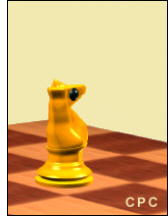 like a horses head which have an
“L” shaped movement. The 2 x 1 move of the traditional Knight was invented over 1500 years ago.
Knights are effective when placed in the center of the board but when placed near the edge lose some of their power:
“A Knight on the rim is very dim.” Knights have the ability of jumping over
major and minor, so you can bring them out early during a game. Because of their leaping ability, Knights work well in blocked positions as they may move to critical cells and stage surprise raids on your opponent. In the endgame, they are at their weakest because of their slow movement which is a
hindrance (compare them with the Bishops). The move of the
Knight is unusual. The Knight is the only major piece which has the ability of leaping over other
major or minor pieces. The other pieces are dependent on their freedom from obstruction by their own and your opponents
pieces. The Knights are the only major pieces which can be moved before the
minor pieces are moved. The King, Queen, both Rooks, and
both Bishops are all hemmed in by the Pawns on rank-2. The
Knights have the liberty of springing over the heads of the other
pieces and enter the field of action instantly. If a
Knight is placed on a light cell in the center of a
empty board, he has access or control to eight dark
coloured cells. like a horses head which have an
“L” shaped movement. The 2 x 1 move of the traditional Knight was invented over 1500 years ago.
Knights are effective when placed in the center of the board but when placed near the edge lose some of their power:
“A Knight on the rim is very dim.” Knights have the ability of jumping over
major and minor, so you can bring them out early during a game. Because of their leaping ability, Knights work well in blocked positions as they may move to critical cells and stage surprise raids on your opponent. In the endgame, they are at their weakest because of their slow movement which is a
hindrance (compare them with the Bishops). The move of the
Knight is unusual. The Knight is the only major piece which has the ability of leaping over other
major or minor pieces. The other pieces are dependent on their freedom from obstruction by their own and your opponents
pieces. The Knights are the only major pieces which can be moved before the
minor pieces are moved. The King, Queen, both Rooks, and
both Bishops are all hemmed in by the Pawns on rank-2. The
Knights have the liberty of springing over the heads of the other
pieces and enter the field of action instantly. If a
Knight is placed on a light cell in the center of a
empty board, he has access or control to eight dark
coloured cells.
If you place a Knight on the side of the board, he may only have access to four cells. Standing in a corner, a
Knight's action is greatly diminished, having only two cells to which to move. Since its introduction to European Chess, the
Knight has not undergone any variation in power or action.
“The L-shaped movement of the Knights
is unique”
The attack of a Knight is more subtle and dangerous than that of any other
major piece, because they attack without putting themselves en prise, and their attack cannot be prevented by the interposition of another
major or minor piece. Due to the Knight's moving ability, they can jump over the other
pieces and wend their way into the penetralia of your opponents position, and if attacked can jump back (retreat) to safety.
The L-shaped movement of the Knights has rendered them the favorite major
piece of many players. In the end phase, a Knight plus three Pawns has the advantage over a Bishop and three Pawns because the
Knight can move from the light to dark cells quite easily.
A Bishop is confined to either the light or dark cells. The Knight is not as useful in defending as a Bishop or Rook because if forced to retreat the
Knight ceases to defend, while a Rook or Bishop can move
back and still offer protection. The Knight is known by different names in differing countries:
Chess piece names in
other languages
|
Language |
Piece name |
Game
name |
|
English |
Knight |
Chess |
|
French |
Cavalier |
Les echecs |
|
German |
Springer |
Schachspiel |
|
Italian |
Cavallo |
Gli scacchi |
|
Spanish |
Caballo |
Ajedrez |
|
Portuguese |
Cavalo |
Xadrez |
|
Russian |
Kon' |
Shahmati |
|
Arabic |
Faras |
Ash-shatranj |
|
Latin |
Equus |
Scaci |
“Knights can attack eight
pieces simultaneously”
Since the Knight can jump over the other major or
minor pieces, he is good on a crowded board. A Knight fork is a deadly coup. A well-posted Knight is as good as a well-posted Bishop, but it takes longer for a
Knight to get to a good post.
Both the Knight and Bishop are less powerful, and therefore less valuable, than
a Rook and the Queen. It may help to think of the Knight as a horse leaping over fences. The
Knight's capture in exactly the same way that they move, replacing the Chess
piece that occupies the cell they land in.
“The Knight's tour”
The “Knight's Tour” is an ancient puzzle in which the object is to move a Knight, starting from any square on a Chess board, to every other square, landing on each square only once. This is usually considered to be a very challenging puzzle.


You may try to play and solve this puzzle at
this link:
http://www.chess-poster.com/english/chess_problems/knight_tour/knight_tour.htm
“The
Knight moves both straight and diagonally”
The Knight is also the only Chess piece which has
an animal head. And look at where the Knight starts on the Chess board between the Rook
and Bishop. Both the Rook and Bishop have the power to
move the entire eight squares one straight and the other
diagonally. The Knight however moves both straight and
diagonally. The Knight can also move over or thru another piece.
It does not take a beginner long to become familiar with the Knight's move and to see at a glance their threats to attack two
pieces at once. Nevertheless, you will often be taken completely by surprise through combinations involving
Knight forks in situations in which the two pieces in question do not stand in a forkable position but are forced into it by a move, usually a sacrifice which you have failed to consider. This is why the
Knight can attack eight pieces simultaneously (in theory!).
In reality, even triple attacks by a Knight are rarely seen in play.
When Knights move, they attack a completely new set of cells. Compare a Knight with the Rook.
A Knight attacks eight entirely new cells when moved. The great disadvantage of the traditional
Knights is that they are a short-range major pieces. This means, that you must post them in the center and as near the enemy position as is safe. Then they will be at their best in making forks and other attacks.
Finally, the one major piece a Knight cannot normally fork is an opposing
Knight, since this could result in an exchange. However,
in Chesmayne there are different types of Knights and these may fork other Knights without being subject to a fork themselves!
It is worth studying carefully the different arrangements of enemy pieces that make a fork possible. This will help you not to miss chances of a fork in play.
First, remember that all cells attacked by a traditional Knight at a given moment are of one colour, the opposite colour to the cell on which the traditional
Knight stands. This means that only pieces which stand in cells of the same colour as each other can be forked by a traditional
Knight. It is important to know the forking combinations very well. An experienced player will think of a fork instantly on seeing the possibility.
“Knights
are the only pieces which can be moved before the Pawns are moved”
A major or minor piece can fork but, this term is usually used in reference to a Knight. A fork by a Knight on the
enemy King and Queen is called a Family Check. Any
Knight can attack two or more major or minor pieces at the same time. A fork is a double attack by one
piece in which two of your opponent's pieces are attacked at the same time. Any
piece can fork, though it is the Knight that most commonly performs this tactic, owing to the special way in which they perform their duties.
A Knight can fork the Queen and Rook, King and Queen, Rook and Bishop, etc, with the result that one of these
major pieces is subsequently eliminated. The Knight may be sacrificed but gain value for the side moving by capturing either Rook or even
the Queen. Sometimes a Knight can fork the Queen, Rook and King
and this type of fork is known as a family fork and can cause some discomfiture to your opponent during a game.
Sometimes a Knight will fork a Bishop and a Pawn. Your opponent being unable to counter both threats thus loses the Pawn. Your opponent will either move or defend the Bishop and you will capture the Pawn and sometimes an
extra check can also be achieved as well.
Other examples are a Rook forking both Bishops at the same time, the Queen forking
both Bishops simultaneously, or the Bishop forking the
King and Bishop and then capturing the Bishop on the succeeding move.
A Pawn can also fork two pieces at the same time. Yet another way a major
piece may fatally lose its mobility is through a fork, a simultaneous attack on two
pieces. Failure to foresee this possibility in actual play could spell disaster.
Movement and capture
The Knight makes a (1, 2)-jump: it moves either two cells in horizontal direction and one in vertical direction, or two cells in vertical direction and one in horizontal direction. It jumps, i.e., it can move regardless whether there are pieces on the intervening cells. Knights take in the same way as they move without taking.
It moves in the shape of a letter L. Two squares forwards or backwards then one square left and right.
Two squares left or right then one square forwards or backwards. Another thing to notice about the Knight move is that if it is on a white square it must move to a black square. And if it is on a black square it has to move to a white square.
Just like the other pieces, the Knight can capture by moving to the square of an enemy piece and taking it off the board. Unlike the other pieces the Knight can
jump over anything in its way, just like a horse.
|
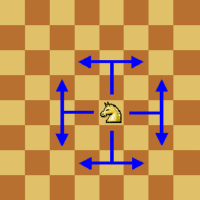
|
|
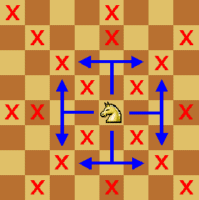
|
| |
|
|
|
The Knight moves
two squares left or right and then one square up or down; or,
two up or down and then one left or right. They always land on a different color square. |
|
|
|
The Knight is not allowed to move like a Bishop as shown above with red marks, neither like a Rook, Queen or any other piece. The Knight movement is unique. |
|
|
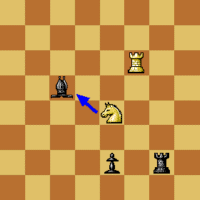 |
|
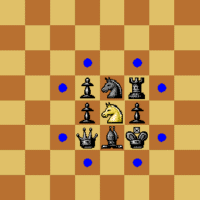 |
| |
|
|
|
The Knight can capture the black Bishop but cannot capture the black Pawn or Rook. The Knight can't move to f6 since is occupied by a friendly piece (white Rook). |
|
|
|
Despite being surrounded by enemy pieces, the Knight can
“jump” over them to any legal square. A Knight placed in the center controls more space.
|
|
|
Notes: for more information on the usual Chess Knight, see Chesmayne
illustrated rules of Chess or the FIDE laws of Chess.
The Knight was a piece that already appeared in the first variant of Chess: Chaturanga. Its movement in nowadays Chess is still the same as it was about one and a half millennium ago. In many languages, the Knight is actually called horse.
Knight graphics
|